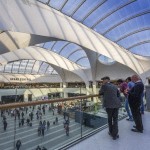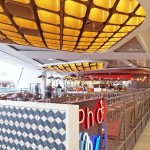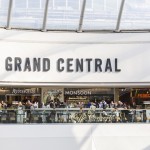By David Leech
The Pallasades Shopping Center was built in 1971 as part of the redevelopment and expansion of New Street Station in Birmingham. This development created a 13-platform railway station, the busiest outside London, with a single-level shopping center above. This once-modern building had become dated and inadequate as both a station and a retail environment. It gave a poor experience of arrival into the United Kingdom’s second city. The existing Pallasades Shopping Centre created a poor impression and low market retailing. As the Pallasades was one of the main routes in and out of the station, it was dominated by fast-moving pedestrians keen to reach their destination rather than spending time or money on the center.

A new design for the station was developed by the client and the council that would reconfigure the station to create better connectivity to the city, more space for traveling customers and a light, modern environment with an atrium. The idea for the exterior of the building, developed by the concept architects AZPML, was to wrap the building in a polished stainless steel façade.
With the refurbishment of the station underway, Haskoll was appointed by Network Rail in 2010 to create a world-class, premium shopping and dining destination above a major transport hub that could be developed without closing the station. Haskoll’s vision was to enhance the customer experience, creating a high-quality retail environment around a new atrium, integrating the station and shopping center to create a sense of destination. This £150-million (€189-million) scheme now provides over 40,000 square meters of retail space with a full-line John Lewis department store, 66 shops, and restaurants, and 450 parking spaces. It will benefit from an estimated footfall of 50 million visitors per annum.
Design Layout

The retail layout was developed to achieve a natural pedestrian flow around the center that is easy to understand and navigate. This builds on the connectivity from the station below. The dining areas are laid out around the atrium, creating a new place to be in the heart of Birmingham. The retail mix of the center was developed to achieve high-end retailing new to Birmingham around the three sides of the atrium, with destination dining experiences around the edges of the atrium. This layout connects into Birmingham’s existing retail offer to form a new prime retail circuit.
The atrium itself took its inspiration from the lines of railway tracks and their junctions. The sinuous lines of the new roof and columns are reminiscent of the points and crossover tracks themselves, with the new public realm and exterior developed from the idea of reflecting the movement of trains, customers, and sky. One of Haskoll’s initial idea was to extend the shopping center to the south to create a four-level department store. This idea fulfilled the requirement for John Lewis, as well as cleverly solving the buildability issues of working within the constraints of a complex existing building. It was this idea that evolved into the scheme that is now built.

The majority of the John Lewis store is located over the area to the south of the station and shopping center that was occupied by two residential towers. This site was clear from the constraints associated with building above the railway tracks and the structural limitations associated with the existing building. This location achieved the spatial requirement of John Lewis for a well laid-out store, dedicated service yard, and connectivity to the car park and associated customer collect. The building also achieves good visibility from the surrounding area.
Design Concept

The interior for Grand Central is built upon the ideas that inspired the design for the station and developed the connections with the romance of train travel, both historic and modern. Birmingham was once renowned for the construction and design of railway carriages and trains. The Birmingham Railway Carriage and Wagon Company was one of the many companies based in and around the local area. The company manufactured carriages for LMS, SR, LNER, GWR, and Pullman as well as foreign train companies in countries as diverse as Egypt, India, Iraq, Malaya, Mandate Palestine, South Africa, and Nigeria.
Birmingham had an international reputation for its standards of workmanship and carriage building, one that naturally progressed to the manufacturing of the automobile. The mall, as a reference, becomes akin to strolling through a very luxurious train carriage carrying only the finest goods. The food terraces become the dining cars with individual booths affording privacy while offering a window into the world via the view into the atrium and the concourse below.
As well as dining on the terrace, cafe units inhabit the spaces at the north and south ends of the atrium. These units have the advantage of 360-degree views of the unit and of the open space above, where the mall ceiling opens up to the ETFE atrium roof above. Flooded by natural daylight during the day, tenants were encouraged to enhance their lighting by localized methods within their demise. Cafe operators within the atrium space provide a sense of place and a convivial and comfortable location in which customers can relax and refuel.
Design Interior Finishes

The design of the new flooring was selected to give a warmth to the center and to provide contrast to the dark and light granite banding used at concourse level. With a pallet of Dura limestone, Nero marble, and wood, the floor layout was developed to reflect both the movement of the customers and the tenant mix. The ceiling features in the food terrace and entry points to the center with their copper and brass colors are reminiscent of the railway carriages of the steam era.
Design guides and reviews with each of the tenants were undertaken to maximize the opportunities for their fit-out designs to share the same vision. This was important for the dining terrace, where clear sightlines and a unique environment at the heart of the center are keys to its ambiance. The scheme as a whole has transformed a poor, dated environment that people wished to escape from quickly to a new destination at the heart of Birmingham. It has created a new understanding of how major transport hubs and retail environments can work together to create a new experience based on quality and openness.
Stakeholder-Comments on Grand Central Birmingham
Sir Albert Bore, Leader of Birmingham City Council: “The redevelopment of Grand Central has been a key project for the city, stimulating economic growth, creating over 1,000 jobs, and acting as a catalyst for regeneration in the surrounding area. With its central location in the heart of the city, it will be a key element of Birmingham’s ever-improving retail and architectural landscape.”
Sam Husain, CEO of Foyles: “Grand Central Birmingham fulfills all of our criteria for a new store—a landmark retail destination with high footfall and a quality retail mix, including our neighbors John Lewis. We look forward to selling books to new customers in the West Midlands, whether they be local residents, visitors to Grand Central Birmingham, or travelers passing through New Street Station.”
Jen Hale, Head of the press office for Kiehl’s: “Grand Central is Birmingham’s newest shopping destination and one of the most striking city-center retail experiences found across Europe. Bringing numerous shops, boutiques, and restaurants into the center of the city and fully integrating with the world class New Street Station, the area joins some of Birmingham’s traditional streets in creating a new landmark building for the city.”





